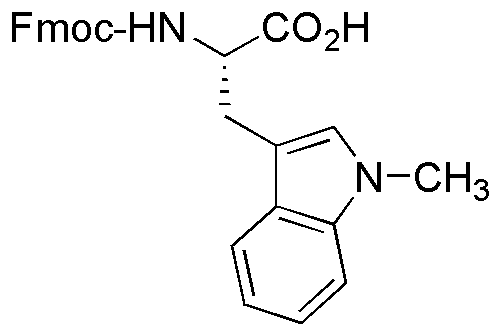Na-Fmoc-Nin-methyl-L-tryptophan is widely utilized in research focused on:
- Peptide Synthesis: This compound serves as a key building block in solid-phase peptide synthesis, allowing researchers to create complex peptides with high purity and yield.
- Drug Development: It plays a significant role in the pharmaceutical industry for developing novel therapeutic peptides, particularly those targeting neurological disorders due to its structural similarity to neurotransmitters.
- Bioconjugation: This chemical is used in bioconjugation processes, enabling the attachment of peptides to various biomolecules, which is essential for creating targeted drug delivery systems.
- Research in Neuroscience: Its unique properties make it valuable in neuroscience research, particularly in studying the effects of tryptophan derivatives on serotonin pathways and mood regulation.
- Fluorescent Labeling: The Fmoc group allows for easy incorporation into fluorescently labeled peptides, facilitating the study of protein interactions in live cells.
General Information
Properties
Safety and Regulations
Applications
Na-Fmoc-Nin-methyl-L-tryptophan is widely utilized in research focused on:
- Peptide Synthesis: This compound serves as a key building block in solid-phase peptide synthesis, allowing researchers to create complex peptides with high purity and yield.
- Drug Development: It plays a significant role in the pharmaceutical industry for developing novel therapeutic peptides, particularly those targeting neurological disorders due to its structural similarity to neurotransmitters.
- Bioconjugation: This chemical is used in bioconjugation processes, enabling the attachment of peptides to various biomolecules, which is essential for creating targeted drug delivery systems.
- Research in Neuroscience: Its unique properties make it valuable in neuroscience research, particularly in studying the effects of tryptophan derivatives on serotonin pathways and mood regulation.
- Fluorescent Labeling: The Fmoc group allows for easy incorporation into fluorescently labeled peptides, facilitating the study of protein interactions in live cells.
Documents
Safety Data Sheets (SDS)
The SDS provides comprehensive safety information on handling, storage, and disposal of the product.
Product Specification (PS)
The PS provides a comprehensive breakdown of the product’s properties, including chemical composition, physical state, purity, and storage requirements. It also details acceptable quality ranges and the product's intended applications.
Certificates of Analysis (COA)
Search for Certificates of Analysis (COA) by entering the products Lot Number. Lot and Batch Numbers can be found on a product’s label following the words ‘Lot’ or ‘Batch’.
*Catalog Number
*Lot Number
Certificates Of Origin (COO)
This COO confirms the country where the product was manufactured, and also details the materials and components used in it and whether it is derived from natural, synthetic, or other specific sources. This certificate may be required for customs, trade, and regulatory compliance.
*Catalog Number
*Lot Number
Safety Data Sheets (SDS)
The SDS provides comprehensive safety information on handling, storage, and disposal of the product.
DownloadProduct Specification (PS)
The PS provides a comprehensive breakdown of the product’s properties, including chemical composition, physical state, purity, and storage requirements. It also details acceptable quality ranges and the product's intended applications.
DownloadCertificates of Analysis (COA)
Search for Certificates of Analysis (COA) by entering the products Lot Number. Lot and Batch Numbers can be found on a product’s label following the words ‘Lot’ or ‘Batch’.
*Catalog Number
*Lot Number
Certificates Of Origin (COO)
This COO confirms the country where the product was manufactured, and also details the materials and components used in it and whether it is derived from natural, synthetic, or other specific sources. This certificate may be required for customs, trade, and regulatory compliance.


